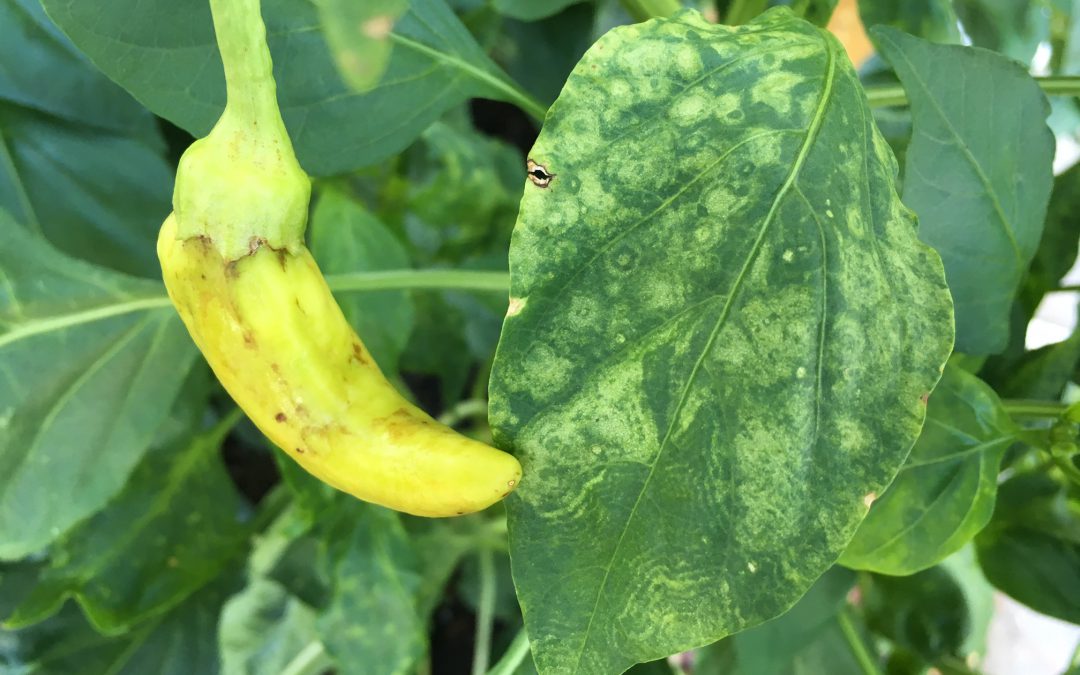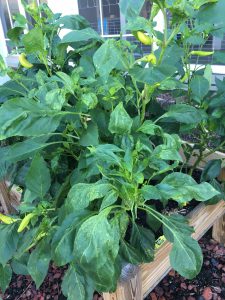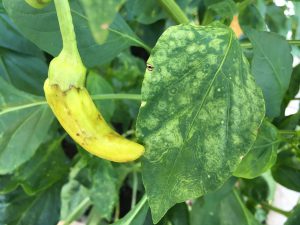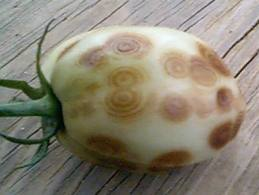
by Mary Salinas | Jul 7, 2016
Peppers and tomatoes are in the same plant family – solanaceae or more commonly known as the nightshade family – and can be susceptible to some of the same diseases. This is true of Tomato Spotted Wilt Virus (TSWV). The solanaceae family includes potatoes, eggplant, tobacco, petunia, tomatillo and deadly nightshade in addition to pepper and tomato.

Pepper with TSWV. Photo credit: Mary Derrick, UF IFAS Extension.
This virus is spread by very small insects known as thrips. They acquire the virus as larvae when feeding on an infected plant and then transmit the disease when they fly to other susceptible plants as adults.
Initial symptoms are yellowing and distortion of the leaves. The leaves can also display yellow or brown circular ring spots. The severity of the virus can depend on the particular cultivar of pepper, its age and the environmental conditions in which the pepper is growing. Fruit can develop yellow, brown or ring spots as well.

TSWV infection showing ring spot on leaves and lesions on fruit. Photo credit: Mary Derrick, UF IFAS Extension.
If you think your pepper has TSWV, consult your local extension agent to confirm the diagnosis. But once infected, there is no treatment for the plants and they should be pulled up and disposed of in the trash to prevent other susceptible plants from becoming infected.
For more information:
Some Common Diseases of Pepper in Florida
by Eddie Powell | Jul 1, 2014

Tomato spotted wilt on leaves
Photo Credits: IFAS

Tomato Spotted Wilt on Fruit
Photo Credit: IFAS
The spotted wilt virus has a wide host range and can affect tomatoes, peppers, plus many other vegetables and ornamental plants. Early symptoms of spotted wilt on tomato are difficult to diagnose. Young, infected plants may show an inward cupping of leaves, and the foliage may appear light color or have a slight bronze cast. As the disease progresses, plants may develop dark brown to black streaks on the main stem. Occasionally the top portion of the plant appears yellow or wilts.
The most characteristic symptom of spotted wilt appears on the fruit. On young fruit white to yellow concentric rings will develop on the fruit skin. The area within the ring typically is raised, which gives the fruit a bumpy appearance. The bright yellow rings on mature red fruit are easily diagnosed as spotted wilt.
The spotted wilt virus is transmitted from plant to plant by several species of a small insect called a thrips. Thrips are less than ¼ inch in length, light green to brown in color and are extremely difficult to find on the plants. It is very important to keep the weeds around the garden controlled because many weedy plants serve as alternate hosts for the virus vectors.
Virus diseases cannot be controlled once the plant is infected. So plant resistant varieties*! Sanitation will help with controlling virus diseases. Infected plants should be removed immediately to prevent spread of the pathogens. Perennial weeds, which may serve as alternate hosts, should be controlled in and adjacent to the garden. Avoid planting tomatoes next to peppers, or other vegetables and flowers susceptible to these diseases. Preventative control of insects, especially thrips, will help reduce the likelihood of spotted wilt.
*BHN 602, Amelia, Crista, Quincy, Bella Rosa, Top Gun, Fletcher, Mountain





